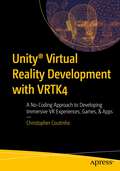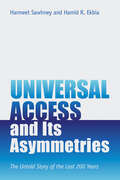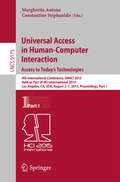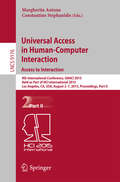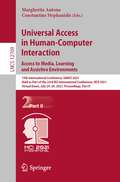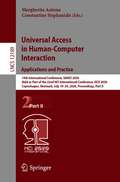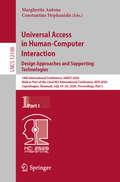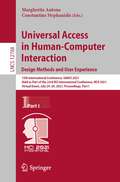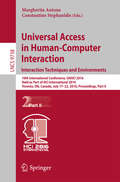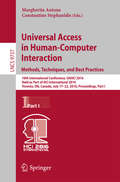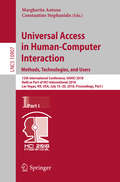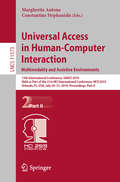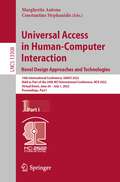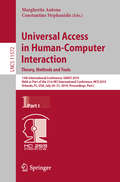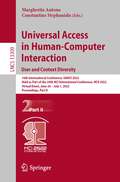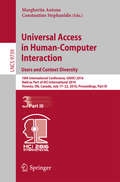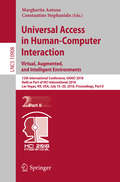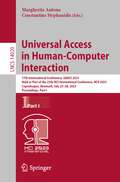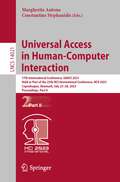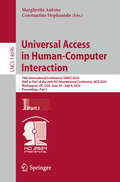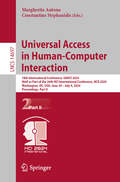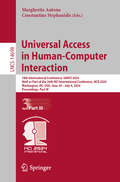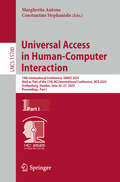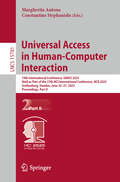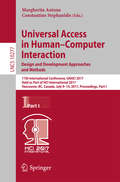- Table View
- List View
Unity® Virtual Reality Development with VRTK4: A No-Coding Approach to Developing Immersive VR Experiences, Games, & Apps
by Christopher CoutinhoGet hands-on practical knowledge of concepts and techniques for VR development using Unity® and VRTK version 4. This book is a step-by-step guide to learning VRTK 4 for developing immersive VR experiences.Unity is a powerful game engine for developing VR experiences. With its built-in support for all major VR headsets, it's the perfect tool for developers to realize their vision in VR. VRTK is a battle-tested VR solution for Unity; VRTK 4, in conjunction with Unity, has changed the dynamics of VR development.This book focuses on creating deep understanding of how advanced VR mechanics and techniques are built and utilized as a part of a VR framework. You will start off by setting up your devices for VR development and learn about the advantages of using VRTK 4 over alternate SDKs. You will learn to setup your very own custom VRTK Rig, find out how to setup various advanced VR mechanics and locomotion techniques, how to create several spatial UI objects, and how to setup Unity 2D UI controls. You will also cover advanced topics such as using angular and linear drives, setting up a VR Simulator to work with a XBox Controller, and realistic physics VR hands. By the end of this book, you will know how to create advanced VR mechanics that can be used within any VR experience, game, or App and deployed across several platforms and hardware.What You Will LearnUnderstand how to develop Immersive VR experiencesCreate a VR simulator to test your projectGenerate advanced Spatial UI that you can interact with physically using your handsWho This Book Is For?Unity game developers conversant with Unity's Editor. Basic knowledge of how Unity Prefabs function, how events work in general, and programming logic would be beneficial.
Universal Access and Its Asymmetries: The Untold Story of the Last 200 Years (Information Policy)
by Hamid R. Ekbia Harmeet SawhneyA framework for understanding the totality of costs and benefits of universal access that will foster honest appraisal and guide the development of good policies.Universal access—the idea that certain technologies and services should be extended to all regardless of geography or ability to pay—evokes ideals of democracy and equality that must be reconciled with the realities on the ground. The COVID-19 pandemic raised awareness of the need for access to high-speed internet service in the United States, but this is just the latest in a long history of debates about what should be made available and to whom. Rural mail delivery, electrification, telephone service, public schooling, and library access each raised the same questions as today&’s debates about health care and broadband. What types of services should be universally available? Who benefits from extending these services? And who bears the cost? Stepping beyond humanitarian arguments to conduct a clear-eyed, diagnostic analysis, this book offers some surprising conclusions. While the conventional approach to universal access looks primarily at the costs to the system and the benefits to individuals, Harmeet Sawhney and Hamid Ekbia provide a holistic perspective that also accounts for costs to individuals and benefits for systems. With a comparative approach across multiple cases, Universal Access and Its Asymmetries is an essential exploration of the history, costs, and benefits of providing universal access to technologies and services. With a fresh perspective, it overturns common assumptions and offers a foundation for making decisions about how to extend service—and how to pay for it.
Universal Access in Human-Computer Interaction. Access to Today's Technologies
by Margherita Antona Constantine StephanidisThe four LNCS volume set 9175-9178 constitutes the refereed proceedings of the 9th International Conference on Learning and Collaboration Technologies, UAHCI 2015, held as part of the 17th International Conference on Human-Computer Interaction, HCII 2015, in Los Angeles, CA, USA in August 2015, jointly with 15 other thematically similar conferences. The total of 1462 papers and 246 posters presented at the HCII 2015 conferences were carefully reviewed and selected from 4843 submissions. These papers of the four volume set address the following major topics: LNCS 9175, Universal Access in Human-Computer Interaction: Access to today's technologies (Part I), addressing the following major topics: LNCS 9175: Design and evaluation methods and tools for universal access, universal access to the web, universal access to mobile interaction, universal access to information, communication and media. LNCS 9176: Gesture-based interaction, touch-based and haptic Interaction, visual and multisensory experience, sign language technologies, and smart and assistive environments LNCS 9177: Universal Access to Education, universal access to health applications and services, games for learning and therapy and cognitive disabilities and cognitive support and LNCS 9178: Universal access to culture, orientation, navigation and driving, accessible security and voting, universal access to the built environment and ergonomics and universal access.
Universal Access in Human-Computer Interaction. Access to Interaction
by Margherita Antona Constantine StephanidisThe four LNCS volume set 9175-9178 constitutes the refereed proceedings of the 9th International Conference on Learning and Collaboration Technologies, UAHCI 2015, held as part of the 17th International Conference on Human-Computer Interaction, HCII 2015, in Los Angeles, CA, USA in August 2015, jointly with 15 other thematically similar conferences. The total of 1462 papers and 246 posters presented at the HCII 2015 conferences were carefully reviewed and selected from 4843 submissions. These papers of the four volume set address the following major topics: LNCS 9175, Universal Access in Human-Computer Interaction: Access to today's technologies (Part I), addressing the following major topics: LNCS 9175: Design and evaluation methods and tools for universal access, universal access to the web, universal access to mobile interaction, universal access to information, communication and media. LNCS 9176: Gesture-based interaction, touch-based and haptic Interaction, visual and multisensory experience, sign language technologies and smart and assistive environments LNCS 9177: Universal Access to Education, universal access to health applications and services, games for learning and therapy, and cognitive disabilities and cognitive support and LNCS 9178: Universal access to culture, orientation, navigation and driving, accessible security and voting, universal access to the built environment and ergonomics and universal access.
Universal Access in Human-Computer Interaction. Access to Media, Learning and Assistive Environments: 15th International Conference, UAHCI 2021, Held as Part of the 23rd HCI International Conference, HCII 2021, Virtual Event, July 24–29, 2021, Proceedings, Part II (Lecture Notes in Computer Science #12769)
by Margherita Antona Constantine StephanidisThis two-volume set constitutes the proceedings of the 15th International Conference on Universal Access in Human-Computer Interaction, UAHCI 2021, held as part of the 23rd International Conference, HCI International 2021, held as a virtual event, in July 2021. The total of 1276 papers and 241 posters included in the 36 HCII 2021 proceedings volumes was carefully reviewed and selected from 5222 submissions. UAHCI 2021 includes a total of 84 regular papers; they focus on topics related to universal access methods, techniques and practices, studies on accessibility, design for all, usability, UX and technology acceptance, emotion and behavior recognition for universal access, accessible media, access to learning and education, as well universal access to virtual and intelligent assistive environments.
Universal Access in Human-Computer Interaction. Applications and Practice: 14th International Conference, UAHCI 2020, Held as Part of the 22nd HCI International Conference, HCII 2020, Copenhagen, Denmark, July 19–24, 2020, Proceedings, Part II (Lecture Notes in Computer Science #12189)
by Margherita Antona Constantine StephanidisThis two-volume set of LNCS 12188 and 12189 constitutes the refereed proceedings of the 14th International Conference on Universal Access in Human-Computer Interaction, UAHCI 2020, held as part of the 22nd International Conference, HCI International 2020, which took place in Copenhagen, Denmark, in July 2020. The conference was held virtually due to the COVID-19 pandemic. The total of 1439 papers and 238 posters have been accepted for publication in the HCII 2020 proceedings from a total of 6326 submissions. UAHCI 2020 includes a total of 80 regular papers which are organized in topical sections named: Design for All Theory, Methods and Practice; User Interfaces and Interaction Techniques for Universal Access; Web Accessibility; Virtual and Augmented Reality for Universal Access; Robots in Universal Access; Technologies for Autism Spectrum Disorders; Technologies for Deaf Users; Universal Access to Learning and Education; Social Media, Digital Services, Inclusion and Innovation; Intelligent Assistive Environments.
Universal Access in Human-Computer Interaction. Design Approaches and Supporting Technologies: 14th International Conference, UAHCI 2020, Held as Part of the 22nd HCI International Conference, HCII 2020, Copenhagen, Denmark, July 19–24, 2020, Proceedings, Part I (Lecture Notes in Computer Science #12188)
by Margherita Antona Constantine StephanidisThis two-volume set of LNCS 12188 and 12189 constitutes the refereed proceedings of the 14th International Conference on Universal Access in Human-Computer Interaction, UAHCI 2020, held as part of the 22nd International Conference, HCI International 2020, which took place in Copenhagen, Denmark, in July 2020. The conference was held virtually due to the COVID-19 pandemic. The total of 1439 papers and 238 posters have been accepted for publication in the HCII 2020 proceedings from a total of 6326 submissions. UAHCI 2020 includes a total of 80 regular papers which are organized in topical sections named: Design for All Theory, Methods and Practice; User Interfaces and Interaction Techniques for Universal Access; Web Accessibility; Virtual and Augmented Reality for Universal Access; Robots in Universal Access; Technologies for Autism Spectrum Disorders; Technologies for Deaf Users; Universal Access to Learning and Education; Social Media, Digital Services, eInclusion and Innovation; Intelligent Assistive Environments.
Universal Access in Human-Computer Interaction. Design Methods and User Experience: 15th International Conference, UAHCI 2021, Held as Part of the 23rd HCI International Conference, HCII 2021, Virtual Event, July 24–29, 2021, Proceedings, Part I (Lecture Notes in Computer Science #12768)
by Margherita Antona Constantine StephanidisThis two-volume set constitutes the proceedings of the 15th International Conference on Universal Access in Human-Computer Interaction, UAHCI 2021, held as part of the 23rd International Conference, HCI International 2021, held as a virtual event, in July 2021. The total of 1276 papers and 241 posters included in the 36 HCII 2021 proceedings volumes was carefully reviewed and selected from 5222 submissions. UAHCI 2021 includes a total of 84 regular papers; they focus on topics related to universal access methods, techniques and practices, studies on accessibility, design for all, usability, UX and technology acceptance, emotion and behavior recognition for universal access, accessible media, access to learning and education, as well universal access to virtual and intelligent assistive environments.
Universal Access in Human-Computer Interaction. Interaction Techniques and Environments
by Margherita Antona Constantine StephanidisThe three-volume set LNCS 9737-9739 constitutes the refereed proceedings of the 10th International Conference on Universal Access in Human-Computer Interaction, UAHCI 2016, held as part of the 10th International Conference on Human-Computer Interaction, HCII 2016, in Toronto, ON, Canada in July 2016, jointly with 15 other thematically similar conferences. The total of 1287 papers presented at the HCII 2016 conferences were carefully reviewed and selected from 4354 submissions. The papers included in the three UAHCI 2016 volumes address the following major topics: novel approaches to accessibility; design for all and eInclusion best practices; universal access in architecture and product design; personal and collective informatics in universal access; eye-tracking in universal access; multimodal and natural interaction for universal access; universal access to mobile interaction; virtual reality, 3D and universal access; intelligent and assistive environments; universal access to education and learning; technologies for ASD and cognitive disabilities; design for healthy aging and rehabilitation; universal access to media and games; and universal access to mobility and automotive.
Universal Access in Human-Computer Interaction. Methods, Techniques, and Best Practices
by Margherita Antona Constantine StephanidisThe three-volume set LNCS 9737-9739 constitutes the refereed proceedings of the 10th International Conference on Universal Access in Human-Computer Interaction, UAHCI 2016, held as part of the 10th International Conference on Human-Computer Interaction, HCII 2016, in Toronto, ON, Canada in July 2016, jointly with 15 other thematically similar conferences. The total of 1287 papers presented at the HCII 2016 conferences were carefully reviewed and selected from 4354 submissions. The papers included in the three UAHCI 2016 volumes address the following major topics: novel approaches to accessibility; design for all and eInclusion best practices; universal access in architecture and product design; personal and collective informatics in universal access; eye-tracking in universal access; multimodal and natural interaction for universal access; universal access to mobile interaction; virtual reality, 3D and universal access; intelligent and assistive environments; universal access to education and learning; technologies for ASD and cognitive disabilities; design for healthy aging and rehabilitation; universal access to media and games; and universal access to mobility and automotive.
Universal Access in Human-Computer Interaction. Methods, Technologies, and Users: 12th International Conference, UAHCI 2018, Held as Part of HCI International 2018, Las Vegas, NV, USA, July 15-20, 2018, Proceedings, Part I (Lecture Notes in Computer Science #10907)
by Margherita Antona Constantine StephanidisThis two-volume set LNCS 10907 and 10908 constitutes the refereed proceedings of the 12th International Conference on Universal Access in Human-Computer Interaction, UAHCI 2018, held as part of HCI International 2018 in Las Vegas, NV, USA, in July 2018.The total of 1170 papers and 195 posters included in the 30 HCII 2018 proceedings volumes was carefully reviewed and selected from 4373 submissions.The 49 papers presented in this volume were organized in topical sections named: design for all, accessibility and usability; alternative I/O techniques, multimodality and adaptation; non-visual interaction; and designing for cognitive disabilities.
Universal Access in Human-Computer Interaction. Multimodality and Assistive Environments: 13th International Conference, UAHCI 2019, Held as Part of the 21st HCI International Conference, HCII 2019, Orlando, FL, USA, July 26–31, 2019, Proceedings, Part II (Lecture Notes in Computer Science #11573)
by Margherita Antona Constantine StephanidisThis two-volume set constitutes the proceedings of the 13th International Conference on Universal Access in Human-Computer Interaction, UAHCI 2019, held as part of the 21st International Conference, HCI International 2019, which took place in Orlando, FL, USA, in July 2019.The total of 1274 papers and 209 posters included in the 35 HCII 2019 proceedings volumes was carefully reviewed and selected from 5029 submissions.UAHCI 2019 includes a total of 95 regular papers; they were organized in topical sections named: universal access theory, methods and tools; novel approaches to accessibility; universal access to learning and education; virtual and augmented reality in universal access; cognitive and learning disabilities; multimodal interaction; and assistive environments.
Universal Access in Human-Computer Interaction. Novel Design Approaches and Technologies: 16th International Conference, UAHCI 2022, Held as Part of the 24th HCI International Conference, HCII 2022, Virtual Event, June 26 – July 1, 2022, Proceedings, Part I (Lecture Notes in Computer Science #13308)
by Margherita Antona Constantine StephanidisThis two-volume set constitutes the refereed proceedings of the 16th International Conference on Universal Access in Human-Computer Interaction, UAHCI 2022, held as part of the 24th International Conference, HCI International 2022, held as a virtual event, in June-July 2022. A total of 1271 papers and 275 posters included in the 39 HCII 2022 proceedings volumes. UAHCI 2022 includes a total of 73 papers; they focus on topics related to universal access methods, techniques and practices, studies on accessibility, design for all, usability, UX and technology acceptance, emotion and behavior recognition for universal access, accessible media, access to learning and education, as well universal access to virtual and intelligent assistive environments.
Universal Access in Human-Computer Interaction. Theory, Methods and Tools: 13th International Conference, UAHCI 2019, Held as Part of the 21st HCI International Conference, HCII 2019, Orlando, FL, USA, July 26–31, 2019, Proceedings, Part I (Lecture Notes in Computer Science #11572)
by Margherita Antona Constantine StephanidisThis two-volume set constitutes the proceedings of the 13th International Conference on Universal Access in Human-Computer Interaction, UAHCI 2019, held as part of the 21st International Conference, HCI International 2019, which took place in Orlando, FL, USA, in July 2019. The total of 1274 papers and 209 posters included in the 35 HCII 2019 proceedings volumes was carefully reviewed and selected from 5029 submissions. UAHCI 2019 includes a total of 95 regular papers; they were organized in topical sections named: universal access theory, methods and tools; novel approaches to accessibility; universal access to learning and education; virtual and augmented reality in universal access; cognitive and learning disabilities; multimodal interaction; and assistive environments.
Universal Access in Human-Computer Interaction. User and Context Diversity: 16th International Conference, UAHCI 2022, Held as Part of the 24th HCI International Conference, HCII 2022, Virtual Event, June 26 – July 1, 2022, Proceedings, Part II (Lecture Notes in Computer Science #13309)
by Margherita Antona Constantine StephanidisThis two-volume set constitutes the refereed proceedings of the 16th International Conference on Universal Access in Human-Computer Interaction, UAHCI 2022, held as part of the 24th International Conference, HCI International 2022, held as a virtual event, in June-July 2022. A total of 1271 papers and 275 posters included in the 39 HCII 2022 proceedings volumes. UAHCI 2022 includes a total of 73 papers; they focus on topics related to universal access methods, techniques and practices, studies on accessibility, design for all, usability, UX and technology acceptance, emotion and behavior recognition for universal access, accessible media, access to learning and education, as well universal access to virtual and intelligent assistive environments.
Universal Access in Human-Computer Interaction. Users and Context Diversity
by Margherita Antona Constantine StephanidisThe three-volume set LNCS 8009-8011 constitutes the refereed proceedings of the 7th International Conference on Universal Access in Human-Computer Interaction, UAHCI 2013, held as part of the 15th International Conference on Human-Computer Interaction, HCII 2013, held in Las Vegas, USA in July 2013, jointly with 12 other thematically similar conferences. The total of 1666 papers and 303 posters presented at the HCII 2013 conferences was carefully reviewed and selected from 5210 submissions. These papers address the latest research and development efforts and highlight the human aspects of design and use of computing systems. The papers accepted for presentation thoroughly cover the entire field of human-computer interaction, addressing major advances in knowledge and effective use of computers in a variety of application areas. The total of 230 contributions included in the UAHCI proceedings were carefully reviewed and selected for inclusion in this three-volume set. The 78 papers included in this volume are organized in the following topical sections: age-related issues, human vision in universal access, emotions and persuasion in universal access, design for autistic spectrum disorders, cognitive issues for universal access, universal access to the Web and social communities.
Universal Access in Human-Computer Interaction. Virtual, Augmented, and Intelligent Environments: 12th International Conference, UAHCI 2018, Held as Part of HCI International 2018, Las Vegas, NV, USA, July 15-20, 2018, Proceedings, Part II (Lecture Notes in Computer Science #10908)
by Margherita Antona Constantine StephanidisThis two-volume set LNCS 10907 and 10908 constitutes the refereed proceedings of the 12th International Conference on Universal Access in Human-Computer Interaction, UAHCI 2018, held as part of HCI International 2018 in Las Vegas, NV, USA, in July 2018.The total of 1170 papers and 195 posters included in the 30 HCII 2018 proceedings volumes was carefully reviewed and selected from 4373 submissions.The 48 papers presented in this volume were organized in topical sections named: virtual and augmented reality for universal access; intelligent assistive environments; and access to the web, social media, education, culture and social innovation.
Universal Access in Human-Computer Interaction: 17th International Conference, UAHCI 2023, Held as Part of the 25th HCI International Conference, HCII 2023, Copenhagen, Denmark, July 23–28, 2023, Proceedings, Part I (Lecture Notes in Computer Science #14020)
by Margherita Antona Constantine StephanidisThis two-volume set constitutes the refereed proceedings of the 17th International Conference on Universal Access in Human-Computer Interaction, UAHCI 2023, held as part of the 25th International Conference, HCI International 2023, in Copenhagen, Denmark, during July 23-28, 2023. The total of 1578 papers and 396 posters included in the HCII 2022 proceedings was carefully reviewed and selected from 7472 submissions. The UAHCI 2023 proceedings were organized in the following topical sections: Part I: Design for All Methods, Tools and Practice; Interaction Techniques, Platforms and Metaphors for Universal Access; Understanding the Universal Access User Experience; and Designing for Children with Autism Spectrum Disorders. Part II: Universal Access to XR; Universal Access to Learning and Education; Assistive Environments and Quality of Life Technologies.
Universal Access in Human-Computer Interaction: 17th International Conference, UAHCI 2023, Held as Part of the 25th HCI International Conference, HCII 2023, Copenhagen, Denmark, July 23–28, 2023, Proceedings, Part II (Lecture Notes in Computer Science #14021)
by Margherita Antona Constantine StephanidisThis two-volume set constitutes the refereed proceedings of the 17th International Conference on Universal Access in Human-Computer Interaction, UAHCI 2023, held as part of the 25th International Conference, HCI International 2023, in Copenhagen, Denmark, during July 23-28, 2023. The total of 1578 papers and 396 posters included in the HCII 2022 proceedings was carefully reviewed and selected from 7472 submissions. The UAHCI 2023 proceedings were organized in the following topical sections: Part I: Design for All Methods, Tools and Practice; Interaction Techniques, Platforms and Metaphors for Universal Access; Understanding the Universal Access User Experience; and Designing for Children with Autism Spectrum Disorders. Part II: Universal Access to XR; Universal Access to Learning and Education; Assistive Environments and Quality of Life Technologies.
Universal Access in Human-Computer Interaction: 18th International Conference, UAHCI 2024, Held as Part of the 26th HCI International Conference, HCII 2024, Washington, DC, USA, June 29 – July 4, 2024, Proceedings, Part I (Lecture Notes in Computer Science #14696)
by Margherita Antona Constantine StephanidisThis three-volume set LNCS 14696-14698 constitutes the refereed proceedings of the 18th International Conference on Universal Access in Human-Computer Interaction, UAHCI 2024, held as part of the 26th International Conference, HCI International 2024, in Washington, DC, USA, during June 29 – July 4, 2024. The total of 1271 papers and 309 posters included in the HCII 2024 proceedings was carefully reviewed and selected from 5108 submissions. The UAHCI 2024 proceedings were organized in the following topical sections: Part I: User Experience Design and Evaluation for Universal Access; AI for Universal Access. Part II: Universal Access to Digital Services; Design for Cognitive Disabilities; Universal Access to Virtual and Augmented Reality. Part III: Universal Access to Learning and Education; Universal Access to Health and Wellbeing; Universal Access to Information and Media.
Universal Access in Human-Computer Interaction: 18th International Conference, UAHCI 2024, Held as Part of the 26th HCI International Conference, HCII 2024, Washington, DC, USA, June 29 – July 4, 2024, Proceedings, Part II (Lecture Notes in Computer Science #14697)
by Margherita Antona Constantine StephanidisThis three-volume set LNCS 14696-14698 constitutes the refereed proceedings of the 18th International Conference on Universal Access in Human-Computer Interaction, UAHCI 2024, held as part of the 26th International Conference, HCI International 2024, in Washington, DC, USA, during June 29 – July 4, 2024. The total of 1271 papers and 309 posters included in the HCII 2024 proceedings was carefully reviewed and selected from 5108 submissions. The UAHCI 2024 proceedings were organized in the following topical sections: Part I: User Experience Design and Evaluation for Universal Access; AI for Universal Access. Part II: Universal Access to Digital Services; Design for Cognitive Disabilities; Universal Access to Virtual and Augmented Reality. Part III: Universal Access to Learning and Education; Universal Access to Health and Wellbeing; Universal Access to Information and Media.
Universal Access in Human-Computer Interaction: 18th International Conference, UAHCI 2024, Held as Part of the 26th HCI International Conference, HCII 2024, Washington, DC, USA, June 29 – July 4, 2024, Proceedings, Part III (Lecture Notes in Computer Science #14698)
by Margherita Antona Constantine StephanidisThis three-volume set LNCS 14696-14698 constitutes the refereed proceedings of the 18th International Conference on Universal Access in Human-Computer Interaction, UAHCI 2024, held as part of the 26th International Conference, HCI International 2024, in Washington, DC, USA, during June 29 – July 4, 2024. The total of 1271 papers and 309 posters included in the HCII 2024 proceedings was carefully reviewed and selected from 5108 submissions. The UAHCI 2024 proceedings were organized in the following topical sections: Part I: User Experience Design and Evaluation for Universal Access; AI for Universal Access. Part II: Universal Access to Digital Services; Design for Cognitive Disabilities; Universal Access to Virtual and Augmented Reality. Part III: Universal Access to Learning and Education; Universal Access to Health and Wellbeing; Universal Access to Information and Media.
Universal Access in Human-Computer Interaction: 19th International Conference, UAHCI 2025, Held as Part of the 27th HCI International Conference, HCII 2025, Gothenburg, Sweden, June 22–27, 2025, Proceedings, Part I (Lecture Notes in Computer Science #15780)
by Margherita Antona Constantine StephanidisThis 2-volume set LNCS 15780-15781 constitutes the refereed proceedings of the 19th International Conference on Universal Access in Human-Computer Interaction, UAHCI 2025, held as part of the 27th International Conference, HCI International 2025, in Gothemburg, Sweden during June 22nd to 27th, 2025. The total of 1430 papers and 355 posters included in the HCII 2025 proceedings was carefully reviewed and selected from 7972 submissions. The two volumes cover topics as follows: Universal Access Theory and Practice Multimodality and UI Adaptation Universal Access and AI Inclusive Virtual and Augmented Reality Inclusive Learning and Playing
Universal Access in Human-Computer Interaction: 19th International Conference, UAHCI 2025, Held as Part of the 27th HCI International Conference, HCII 2025, Gothenburg, Sweden, June 22–27, 2025, Proceedings, Part II (Lecture Notes in Computer Science #15781)
by Margherita Antona Constantine StephanidisThis 2-volume set LNCS 15780-15781 constitutes the refereed proceedings of the 19th International Conference on Universal Access in Human-Computer Interaction, UAHCI 2025, held as part of the 27th International Conference, HCI International 2025, in Gothemburg, Sweden during June 22nd to 27th, 2025. The total of 1430 papers and 355 posters included in the HCII 2025 proceedings was carefully reviewed and selected from 7972 submissions. The two volumes cover topics as follows: Universal Access Theory and Practice Multimodality and UI Adaptation Universal Access and AI Inclusive Virtual and Augmented Reality Inclusive Learning and Playing
Universal Access in Human–Computer Interaction. Design and Development Approaches and Methods
by Margherita Antona Constantine StephanidisThe three-volume set LNCS 10277-10279 constitutes the refereed proceedings of the11th International Conference on Universal Access in Human-Computer Interaction, UAHCI 2017, held as part of the 19th International Conference on Human-Computer Interaction, HCII 2017, in Vancouver, BC, Canada in July 2017, jointly with 14 other thematically similar conferences. The total of 1228 papers presented at the HCII 2017 conferences were carefully reviewed and selected from 4340 submissions. The papers included in the three UAHCI 2017 volumes address the following major topics: Design for All Methods and Practice; Accessibility and Usability Guidelines and Evaluation; User and Context Modelling and Monitoring and Interaction Adaptation; Design for Children; Sign Language Processing; Universal Access to Virtual and Augmented Reality; Non Visual and Tactile Interaction; Gesture and Gaze-Based Interaction; Universal Access to Health and Rehabilitation; Universal Access to Education and Learning; Universal Access to Mobility; Universal Access to Information and Media; and Design for Quality of Life Technologies.
